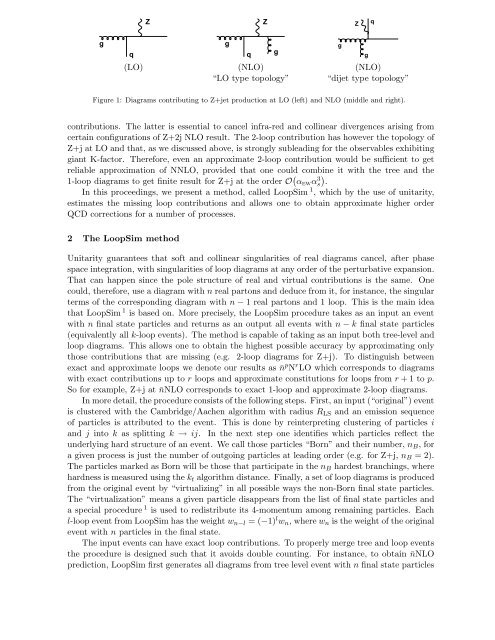2011 QCD and High Energy Interactions - Rencontres de Moriond ...
2011 QCD and High Energy Interactions - Rencontres de Moriond ...
2011 QCD and High Energy Interactions - Rencontres de Moriond ...
You also want an ePaper? Increase the reach of your titles
YUMPU automatically turns print PDFs into web optimized ePapers that Google loves.
g<br />
q<br />
(LO)<br />
Z<br />
g<br />
q<br />
Z<br />
g<br />
(NLO)<br />
“LO type topology”<br />
g<br />
Z<br />
g<br />
(NLO)<br />
“dijet type topology”<br />
Figure 1: Diagrams contributing to Z+jet production at LO (left) <strong>and</strong> NLO (middle <strong>and</strong> right).<br />
contributions. The latter is essential to cancel infra-red <strong>and</strong> collinear divergences arising from<br />
certain configurations of Z+2j NLO result. The 2-loop contribution has however the topology of<br />
Z+j at LO <strong>and</strong> that, as we discussed above, is strongly subleading for the observables exhibiting<br />
giant K-factor. Therefore, even an approximate 2-loop contribution would be sufficient to get<br />
reliable approximation of NNLO, provi<strong>de</strong>d that one could combine it with the tree <strong>and</strong> the<br />
1-loop diagrams to get finite result for Z+j at the or<strong>de</strong>r O αewα3 <br />
s .<br />
In this proceedings, we present a method, called LoopSim 1 , which by the use of unitarity,<br />
estimates the missing loop contributions <strong>and</strong> allows one to obtain approximate higher or<strong>de</strong>r<br />
<strong>QCD</strong> corrections for a number of processes.<br />
2 The LoopSim method<br />
Unitarity guarantees that soft <strong>and</strong> collinear singularities of real diagrams cancel, after phase<br />
space integration, with singularities of loop diagrams at any or<strong>de</strong>r of the perturbative expansion.<br />
That can happen since the pole structure of real <strong>and</strong> virtual contributions is the same. One<br />
could, therefore, use a diagram with n real partons <strong>and</strong> <strong>de</strong>duce from it, for instance, the singular<br />
terms of the corresponding diagram with n − 1 real partons <strong>and</strong> 1 loop. This is the main i<strong>de</strong>a<br />
that LoopSim 1 is based on. More precisely, the LoopSim procedure takes as an input an event<br />
with n final state particles <strong>and</strong> returns as an output all events with n − k final state particles<br />
(equivalently all k-loop events). The method is capable of taking as an input both tree-level <strong>and</strong><br />
loop diagrams. This allows one to obtain the highest possible accuracy by approximating only<br />
those contributions that are missing (e.g. 2-loop diagrams for Z+j). To distinguish between<br />
exact <strong>and</strong> approximate loops we <strong>de</strong>note our results as ¯n p N r LO which corresponds to diagrams<br />
with exact contributions up to r loops <strong>and</strong> approximate constitutions for loops from r + 1 to p.<br />
So for example, Z+j at ¯nNLO corresponds to exact 1-loop <strong>and</strong> approximate 2-loop diagrams.<br />
In more <strong>de</strong>tail, the procedure consists of the following steps. First, an input (“original”) event<br />
is clustered with the Cambridge/Aachen algorithm with radius RLS <strong>and</strong> an emission sequence<br />
of particles is attributed to the event. This is done by reinterpreting clustering of particles i<br />
<strong>and</strong> j into k as splitting k → ij. In the next step one i<strong>de</strong>ntifies which particles reflect the<br />
un<strong>de</strong>rlying hard structure of an event. We call those particles “Born” <strong>and</strong> their number, nB, for<br />
a given process is just the number of outgoing particles at leading or<strong>de</strong>r (e.g. for Z+j, nB = 2).<br />
The particles marked as Born will be those that participate in the nB har<strong>de</strong>st branchings, where<br />
hardness is measured using the kt algorithm distance. Finally, a set of loop diagrams is produced<br />
from the original event by “virtualizing” in all possible ways the non-Born final state particles.<br />
The “virtualization” means a given particle disappears from the list of final state particles <strong>and</strong><br />
a special procedure 1 is used to redistribute its 4-momentum among remaining particles. Each<br />
l-loop event from LoopSim has the weight wn−l = (−1) l wn, where wn is the weight of the original<br />
event with n particles in the final state.<br />
The input events can have exact loop contributions. To properly merge tree <strong>and</strong> loop events<br />
the procedure is <strong>de</strong>signed such that it avoids double counting. For instance, to obtain ¯nNLO<br />
prediction, LoopSim first generates all diagrams from tree level event with n final state particles<br />
q








![List of participants 27/2/09 [pdf] - Rencontres de Moriond - IN2P3](https://img.yumpu.com/17975746/1/190x135/list-of-participants-27-2-09-pdf-rencontres-de-moriond-in2p3.jpg?quality=85)







